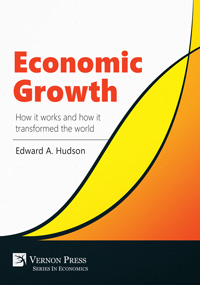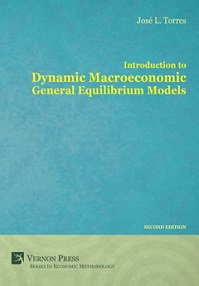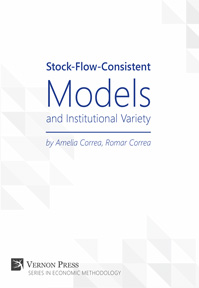Understanding DSGE models
Theory and Applications
by Celso Jose Costa Junior (São Paulo School of Economics, Brazil)
Purchase this book
(click here to change currency)
"This book teaches DSGE models from scratch. It explains the basic economic relations behind the models; discusses their assumptions; derives the results step by step; presents computer codes that solve each model covered in the book; and shows the results. The book will appeal to students, scholars and professionals interested in acquaint themselves with modern macroeconomics and to those searching for a detailed guide for solving DSGE models."
Bernardo Guimarães
Sao Paulo School of Economics – FGV
"[...]The book "UNDERSTANDING DSGE" by Celso J. Costa Junior is an outstanding valuable tool for helping graduate students and researchers cope with the intricacies of setting up Dynamic Stochastic General Equilibrium models.
"[...]Celso J. Costa's book stands out in that it proves very successful in walking the reader through the whole process of setting up a complete Dynamic Stochastic General Equilibrium model, which can be at times daunting enough to discourage the beginners from continuing this long journey.
"At the beginning of many chapters, the author takes pains to explain concepts underlying each model in a simple undergraduate-like -but nonetheless in a detailed- way, using for example a two-periods model to teach the reader how the representative consumer makes the optimal intertemporal choice. This is a feature that clearly puts itself ahead of the game as it makes the textbook accessible to advanced undergraduates as well.
"It patiently teaches how to derive the steady state and the log-linearization involved. Not many competitors, if any, do it in the same detailed user-friendly way as Celso Costa does.
"The boxes that the author intersperses in every chapter explaining and clarifying concepts. They clearly help.
"The content in itself. The first model presented is the Real Business Cycle (RBC) model, which constitutes the backbone of the DSGE models. After it, Celso J. Costa adds frictions to this basic model in a cumulative way: sticky prices, rigid wages, habit formation and hand-to-mouth consumers, adjustment costs and under-utilization of the maximum installed capacity and government.
"[...]Celso Costa's book is an indispensable book intended for the student, be the advanced Econ undergraduate, be the graduate (Masters and PhD) student, and for any researcher avid to learn this modeling technique, and it makes a major contribution to the learning process of this kind of macroeconomic models."
Alejandro C. García Cintado
Department of Economics, Quantitative Methods and Economic History, Universidad Pablo Olavide Sevilla
"The Microfoundations, Intertemporal Decisions and Uncertainty is the center of modern macroeconomics, like Real Business Cycles Model and New Keynesian Model. The book Understanding DSGE written by Professor Costa Junior has the intention to introduce this literature to begin research, where some details about the elaboration of the model studied step by step. This type of approach is not found in other books that analyze this type of models.
"The book’s strong point is the determination of the State-Steady and its linearization in detail and how to put the equilibrium condition in the Dynare."
Armando Vaz Sampaio – Adjunct Professor at Federal University of Paraná.
While the theoretical development of DSGE models is not overly difficult to understand, practical application remains somewhat complex. The literature on this subject has some significant obscure points. This book can be thought of, firstly, as a tool to overcome initial hurdles with this type of modeling. Secondly, by showcasing concrete applications, it aims to persuade incipient researchers to work with this methodology. In principle, this is not a book on macroeconomics in itself, but on tools used in the construction of this sort of models. It strives to present this technique in a detailed manner, thereby providing a step by step course intended to walk readers through this otherwise daunting process. The book begins with a basic Real Business Cycle model. Subsequently various frictions are gradually incorporated into a standard DSGE model: imperfect competition; frictions in prices and in wages ; habit formation; non-Ricardian agents; adjustment cost in investment; costs of not using the maximum installed capacity; and finally, Government.
1 Introduction
1.1 The idea of the Representative Agent and his or her lifetime
1.2 Teaching DSGE models at undergraduate and graduate levels
1.3 Dynare
1.4 The structure of this book
2 Basic Real Business Cycle Model (RBC)
2.1 Brief theoretical review: Real Business Cycle
2.1.1 "Two-good" model: consumption and leisure
2.1.2 Dynamic structure of the consumption-saving trade-off
2.1.3 Input markets
2.2 The model
2.2.1 Households
2.2.2 Firms
2.2.3 Equilibrium conditions
2.2.4 Steady state
2.2.5 Log-linearization (Uhlig's method)
2.3 Productivity shocks
3 Basic New-Keynesian model (NK)
3.1 Brief theoretical review: New-Keynesians
3.1.1 Differentiated goods and consumption aggregator
3.1.2 Monopolistically competitive firms
3.1.3 Price stickiness
3.2 The model
3.2.1 Households
3.2.2 Firms
3.2.3 Equilibrium conditions
3.2.4 Steady state
3.2.5 Log-linearization (Uhlig's method)
3.3 Productivity shocks
4 New-Keynesian model with sticky wages
4.1 Brief theoretical review: sticky wages
4.1.1 Why would wages be sticky in the short run?
4.2 The model
4.2.1 Households
4.2.2 Firms
4.2.3 Equilibrium conditions
4.2.4 Steady state
4.2.5 Log-linearization (Uhlig's method)
4.3 Productivity shocks
4.3.1 How costly would it be in terms of the lack of realism to pick a model without these price and wage frictions over a model including them?
5 New-Keynesian model with habit formation and non-ricardian agents
5.1 Brief theoretical review: household-related frictions
5.1.1 Habit formation
5.1.2 Non-ricardian agents
5.2 The model
5.2.1 Households
5.2.2 Firms
5.2.3 Equilibrium conditions
5.2.4 Steady state
5.2.5 Log-linearization (Uhlig's method)
5.3 Productivity shocks
5.3.1 How costly would it be in terms of the lack of realism to pick a model without these household-related frictions (habit formation and non-ricardian agents) over a model including them?
6 The New-Keynesian model with investment adjustment costs and variable capital utilization
6.1 Brief theoretical review: investment adjustment costs and variable capital utilization
6.1.1 Investment adjustment costs
6.1.2 Variable capital utilization costs
6.2 The model
6.2.1 Households
6.2.2 Firms
6.2.3 Equilibrium conditions
6.2.4 Steady state
6.2.5 Log-linearization (Uhlig's method)
6.3 Productivity shocks
7 New-Keynesian model with government
7.1 Brief theoretical review: Government
7.1.1 Introducing taxes into DSGE models
7.1.2 Government budget constraint
7.1.3 Public Investment
7.1.4 Alternative ways of government in DSGE models
7.1.5 Taylor rule
7.2 The model
7.2.1 Households
7.2.2 Firms
7.2.3 Government
7.2.4 Equilibrium conditions
7.2.5 Steady state
7.2.6 Log-linearization (Uhlig's method)
7.3 Shocks to productivity, to monetary and fiscal policies and Laffer curve analysis
7.3.1 Shocks to productivity and to monetary policy
7.3.2 Shocks to fiscal policy
7.3.3 Using taxes in the fiscal adjustment
7.3.4 Laffer curve
References
Appendices
A Mathematical tools.
A.1 Lagrange optimization
A.1.1 An example
A.2 Matrix and eigenvalue operations
A.2.1 Matrix addition and subtraction
A.2.2 Matrix multiplication
A.2.3 Inverse matrix calculation
A.2.4 Eigenvalues
B Basic ideas about DSGE
B.1 Calibration
B.2 Blanchard e Kahn (BK)'s condition for the existence of a unique stable solution
B.2.1 A textbook example: Chapter 2's RBC model
Celso Costa is Lecturer and Associated Researcher at the Brazilian Macro Center - São Paulo School of Economics (EESP) – FGV recognized as one of the top schools of economics in Latin America. And Adjunct Professor at Universidade Estadual de Ponta Grossa - UEPG. Prior to his present roles, he completed a Post-doctorate in Economics at EESP. He holds a PhD in Economic Development from Universidade Federal do Paraná - UFPR, a Masters degree in Economics from Universidade Estadual Paulista – UNESP and a Bachelor degree in Geophysics from Universidade de São Paulo – USP.
See also
Bibliographic Information
Book Title
Understanding DSGE models
Book Subtitle
Theory and Applications
ISBN
978-1-62273-038-4
Edition
1st
Number of pages
280
Physical size
236mm x 160mm

![Understanding DSGE models [Hardback]](/file/1382/4eee223591c766df4274982ff636c31c/1456864595.jpg)






